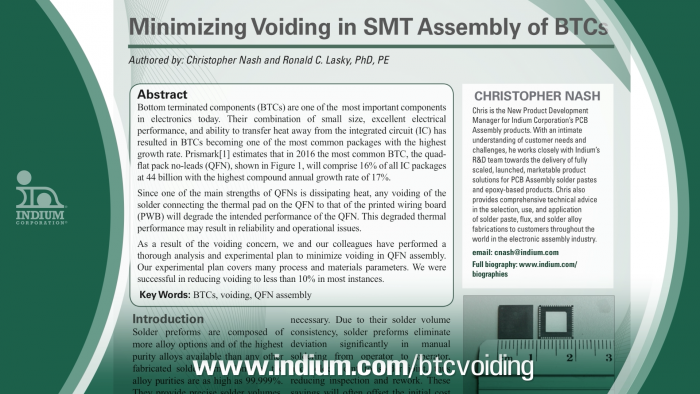Dr. Ronald C. Lasky: I presented a paper at SMTAI 2016 on reducing voids in bottom terminated components.
A little background on SMTA. SMTA, or Surface Mount Technology Association, was started in 1984 as a non-profit organization to foster education in the then new field of surface mount electronic assembly. Since then it has expanded to include all of electronic assembly. For many of us, it is our favorite industry organization, as it is very collegial, it feels almost like a family. SMTA has also stayed true to its educational mission. SMTAI is their international conference and exhibition. It is the one conference I always try to attend.
My paper is Minimizing Voiding in SMT Assembly of Bottom Terminating Components, or BTCs. Indium Corporation's Chris Nash performed all the experiments, and I analyzed the data and took the lead in writing the paper. I think the paper is significant in that Chris performed experiments on many of the important factors that would effect voiding. We determined some interesting and one profoundly significant conclusion. Chris used two re-flow thermal profiles.
Profile 1 was a ramp-to-peak profile with a maximum temperature of approximately 240°C, whereas Profile 2 had a slight soak and a peak of 254°C and also had a slightly higher time above liquidous of 77 seconds vs. 70 seconds. We expected Profile 2, which is hotter, to reduce voiding some, but were surprised that reduction was from 22% to a little less than 8%, a reduction of more than 14%, which we think is quite impressive. Our theory is that the hotter profile is more successful at driving out the flux volatiles.
The second conclusion was related to stencil thickness. Chris performed experiments with 4 and 5 mil thick stencils. The five mil stencils reduced voiding by only 4% as compared to the 4 mil stencils but the result was statistically significant. We think that the hotter standoff of the five mil stencils allows flux volatiles to escape more easily. Thirdly, in testing Type 4, Type 4.5, and Type 5 paste, there was not statistical difference in void formation among them at 11 to 14% or so; however, Type 3 paste was much more, at 15% higher, voiding at 30%.
The most significant conclusion was that we found that the solder paste alone can have a profound effect. Under the same experimental conditions, we were able to reduce voiding from 45% to less than 10% by selecting a solder paste designed to reduce voiding. This is really important to those struggling with voiding under bottom terminated components. By simply switching to a superior solder paste, one has a very high chance of solving a voiding problem. The top X-ray images show poor area voiding percentages, greater than 30%, while the bottom photos show voiding of less than 10%.
For more information, email me at rlasky@indium.com or visit the website www.indium.com to read my paper.


